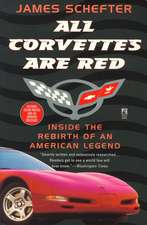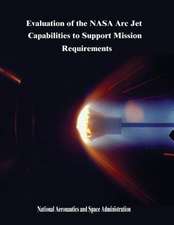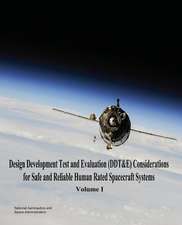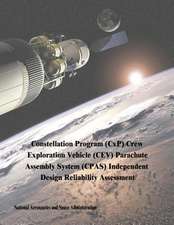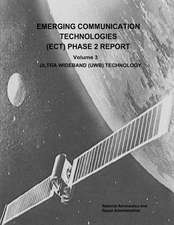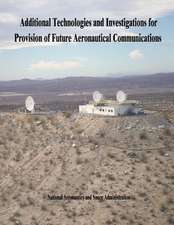The Race
Autor James Schefteren Limba Engleză Paperback – 12 iun 2000
| Toate formatele și edițiile | Preț | Express |
|---|---|---|
| Paperback (2) | 97.22 lei 3-5 săpt. | |
| Anchor Books – 30 iun 2000 | 97.22 lei 3-5 săpt. | |
| CORNERSTONE – 12 iun 2000 | 100.19 lei 6-8 săpt. |
Preț: 100.19 lei
Nou
Puncte Express: 150
Preț estimativ în valută:
19.17€ • 20.07$ • 15.90£
19.17€ • 20.07$ • 15.90£
Carte tipărită la comandă
Livrare economică 09-23 aprilie
Preluare comenzi: 021 569.72.76
Specificații
ISBN-13: 9780099406143
ISBN-10: 0099406144
Pagini: 320
Ilustrații: illustrations
Dimensiuni: 129 x 197 x 20 mm
Greutate: 0.22 kg
Editura: CORNERSTONE
Locul publicării:United Kingdom
ISBN-10: 0099406144
Pagini: 320
Ilustrații: illustrations
Dimensiuni: 129 x 197 x 20 mm
Greutate: 0.22 kg
Editura: CORNERSTONE
Locul publicării:United Kingdom
Notă biografică
James Schefter was Time-Life's NASA correspondent from 1963 to 1973. His work has appeared in magazines as diverse as Popular Science, Reader's Digest and Paris Match. He is the author of All Corvettes Are Red: The Rebirth of an American Legend. He lives in Park City, Utah.
Extras
He stood awkwardly, looking out the window at a gray and dusty landscape. It had been a long trip, either four days or fourteen years depending on your perspective. Now it was time to finish it. In the next five minutes, he had to go out there. Then he had to make a comment for the record.
I have no idea what to say.
He raised his eyes to the horizon only six miles away. Between here and there, nothing changed much. But between there and here, everything has changed. How did we get from there to here?
He looked down to the ground and it didn't seem so far away. It's just a small . . . His mind took the thought and raced to the logical conclusion. Of course! It's both. It's always been both. That's what I should say.
With a nod to his partner and an unseen smile, he turned around, crouched, and began to back out. The porch sloped down just a bit. The steps were easy, but the last one was higher than he'd expected. He jumped into the big circular dish at the bottom and still hadn't touched ground.
An entire world watched grainy black-and-white television images of his progress. Listened to him briefly describe what he saw. Wished he'd get on with it.
"Okay." His voice was scratchy with distance and static. "I'm going to step off the LM now."
He put his left foot down into the dust. Felt that the ground was solid underneath. Took a deep breath. And spoke to history.
"That's one small step for man . . ."
Chapter 1
Nobody believed Leo Sedov.
It seemed absurd, talking about Russian rockets and space travel, but there he was, a senior Soviet scientist calling a press conference in Copenhagen to make yet another absurd claim about his country's technological greatness. Such claims were so common in the 1950s that even the Sunday funnies parodied them. Americans were accustomed to reading claims that Russians had invented the bicycle, the electric lightbulb, the telephone.
Americans laughed at the peasant Russians and understood that only a backward people with a great inferiority complex could be so silly. Hadn't America only recently provided Russia with the technology and hardware they lacked, so they could help win World War II? And then the ungrateful louts had responded with coarseness, spitting in the American face by blockading Berlin, by creating an iron curtain across Europe, by pretending to be better than they were.
Now this. The Sixth Congress of the International Astronautical Federation was convened in Copenhagen, and for the first time, the upstart Russians were there, if only as observers. The important people, the participants, were from the Western and developed countries. But here stood Academician Leonid I. Sedov, a Soviet physicist, telling fifty or so reporters at the Soviet embassy that the Soviet Union would soon put an artificial satellite into orbit around Earth.
He didn't tell them that the idea of a satellite was already old news in his country. Two experienced Russian rocket men had been pushing the idea for more than a year. One was Mikhail Tikhonravov, whose 1954 paper laid out technical details for a satellite. His latest revision of that paper was barely two weeks old when Sedov stood before the press in Copenhagen. The other was a mysterious figure known only as the Chief Designer. An old friend of Tikhonravov's, he would carry the satellite idea into the corridors of Soviet power and place it before commissions, department ministers, and even Premier Nikita Khrushchev himself. None of this was known to westerners when Sedov spoke. Seeing the skeptical looks in the audience, particularly on the faces of the American reporters, Sedov said it again even more forcefully: "The realization of the Soviet project can be expected in the near future."
The date was August 2, 1955.
Only four days earlier, James C. Hagerty, press secretary to President Dwight Eisenhower, had made a similar announcement in Washington. The United States, Hagerty said, would break out into space with "small Earth-circling satellites" during the eighteen-month-long International Geophysical Year (IGY) that would begin July 1, 1957. It was a fantastic proposal, but coming from Americans, at least it didn't sound crazy. Rocket technology in the mid-1950s was almost good enough to reach space. If it could get just a little better--able to push a small payload to 17,500 miles an hour--that would be fast enough to overcome gravity.
The IGY had been years in planning, an international study of the upper atmosphere and outer space with high-altitude balloons, sounding rockets, ground-based telescopes, and other instruments. An IGY committee approved an American-sponsored proposal in October 1954 to include satellites on the research list, but until the White House announcement nearly ten months later, no country had stepped up to that particular challenge.
Now the Russians--the Russians!--were going into space too, and in the "near future" no less. The New York Times gave the story fewer than four hundred words on an inside page, under a one-column headline reading SOVIET PLANNING EARLY SATELLITE Russian Expert in Denmark Says Success in 2 Years Is "Quite Possible'
Across the broad stretch of America, where small-town dailies, not the mighty Times, were the choice of readers, and where television had yet to make a major impact, the story was a nonstarter. For all the serious attention he got in the United States, Professor Sedov might as well have made his prediction in the Sunday funnies. Certainly more Americans would have seen it. But except for a few scientists in the inner circle of U.S. rocketry, none would have believed it.
Nor would the average American have believed the decision reached twenty-eight days later in Moscow. The shadowy Chief Designer convinced his peers in the Soviet Academy of Sciences to create a commission that would oversee launch of an orbiting satellite before the beginning of the IGY. The Chief Designer's timing had only one purpose: to beat the United States of America into space. It still needed official government approval and that would come in a matter of months. But still, there it was. The space race that would change the face of science, technology, human spirit, and international politics was announced in a public press conference on August 2 and de facto began on August 30, 1955.
Only one of the two participants heard the starter's pistol. The last thing President Eisenhower wanted was any kind of race with the Russians. Some of his advisers thought differently, but Ike was the boss.
Historians agree on those points. They disagree about why Ike was so adamant. Each round of declassified national security documents from the late 1950s to the mid-1960s gives rise to new interpretations about Ike's inexplicable blindness to the terrible impact of losing a race he may not even have known he was running. A word, a wink, a nod from the president of the United States on the subject of quickly putting a satellite, any satellite, into orbit around Earth would have changed the course of mid-twentieth-century history and avoided the worst crisis of his presidency.
But still, Ike was warned. Even Harry Truman had been warned. Way back in 1946, when German rocket parts and Wernher von Braun's rocket team were in exile-residence at the Army's Fort Bliss, by El Paso, Texas, a RAND Corporation report called it right: "The achievement of a satellite craft by the United States would inflame the imagination of mankind, and would probably produce repercussions in the world comparable to the explosion of the atomic bomb."
World War II had just ended and nobody in power cared. Von Braun, of course, cared, but he was still a captured German scientist yet to prove himself to his new American masters. At a backwater research facility in Langley, Virginia, a few others dared to think about spaceflight too. But they had their hands full with advanced research on aeronautics and upper-atmosphere phenomena, so they didn't think about it much. Their names would become legendary in the race Eisenhower wasn't running. Bob Gilruth. Max Faget. Chris Kraft. But that came much later.
I have no idea what to say.
He raised his eyes to the horizon only six miles away. Between here and there, nothing changed much. But between there and here, everything has changed. How did we get from there to here?
He looked down to the ground and it didn't seem so far away. It's just a small . . . His mind took the thought and raced to the logical conclusion. Of course! It's both. It's always been both. That's what I should say.
With a nod to his partner and an unseen smile, he turned around, crouched, and began to back out. The porch sloped down just a bit. The steps were easy, but the last one was higher than he'd expected. He jumped into the big circular dish at the bottom and still hadn't touched ground.
An entire world watched grainy black-and-white television images of his progress. Listened to him briefly describe what he saw. Wished he'd get on with it.
"Okay." His voice was scratchy with distance and static. "I'm going to step off the LM now."
He put his left foot down into the dust. Felt that the ground was solid underneath. Took a deep breath. And spoke to history.
"That's one small step for man . . ."
Chapter 1
Nobody believed Leo Sedov.
It seemed absurd, talking about Russian rockets and space travel, but there he was, a senior Soviet scientist calling a press conference in Copenhagen to make yet another absurd claim about his country's technological greatness. Such claims were so common in the 1950s that even the Sunday funnies parodied them. Americans were accustomed to reading claims that Russians had invented the bicycle, the electric lightbulb, the telephone.
Americans laughed at the peasant Russians and understood that only a backward people with a great inferiority complex could be so silly. Hadn't America only recently provided Russia with the technology and hardware they lacked, so they could help win World War II? And then the ungrateful louts had responded with coarseness, spitting in the American face by blockading Berlin, by creating an iron curtain across Europe, by pretending to be better than they were.
Now this. The Sixth Congress of the International Astronautical Federation was convened in Copenhagen, and for the first time, the upstart Russians were there, if only as observers. The important people, the participants, were from the Western and developed countries. But here stood Academician Leonid I. Sedov, a Soviet physicist, telling fifty or so reporters at the Soviet embassy that the Soviet Union would soon put an artificial satellite into orbit around Earth.
He didn't tell them that the idea of a satellite was already old news in his country. Two experienced Russian rocket men had been pushing the idea for more than a year. One was Mikhail Tikhonravov, whose 1954 paper laid out technical details for a satellite. His latest revision of that paper was barely two weeks old when Sedov stood before the press in Copenhagen. The other was a mysterious figure known only as the Chief Designer. An old friend of Tikhonravov's, he would carry the satellite idea into the corridors of Soviet power and place it before commissions, department ministers, and even Premier Nikita Khrushchev himself. None of this was known to westerners when Sedov spoke. Seeing the skeptical looks in the audience, particularly on the faces of the American reporters, Sedov said it again even more forcefully: "The realization of the Soviet project can be expected in the near future."
The date was August 2, 1955.
Only four days earlier, James C. Hagerty, press secretary to President Dwight Eisenhower, had made a similar announcement in Washington. The United States, Hagerty said, would break out into space with "small Earth-circling satellites" during the eighteen-month-long International Geophysical Year (IGY) that would begin July 1, 1957. It was a fantastic proposal, but coming from Americans, at least it didn't sound crazy. Rocket technology in the mid-1950s was almost good enough to reach space. If it could get just a little better--able to push a small payload to 17,500 miles an hour--that would be fast enough to overcome gravity.
The IGY had been years in planning, an international study of the upper atmosphere and outer space with high-altitude balloons, sounding rockets, ground-based telescopes, and other instruments. An IGY committee approved an American-sponsored proposal in October 1954 to include satellites on the research list, but until the White House announcement nearly ten months later, no country had stepped up to that particular challenge.
Now the Russians--the Russians!--were going into space too, and in the "near future" no less. The New York Times gave the story fewer than four hundred words on an inside page, under a one-column headline reading SOVIET PLANNING EARLY SATELLITE Russian Expert in Denmark Says Success in 2 Years Is "Quite Possible'
Across the broad stretch of America, where small-town dailies, not the mighty Times, were the choice of readers, and where television had yet to make a major impact, the story was a nonstarter. For all the serious attention he got in the United States, Professor Sedov might as well have made his prediction in the Sunday funnies. Certainly more Americans would have seen it. But except for a few scientists in the inner circle of U.S. rocketry, none would have believed it.
Nor would the average American have believed the decision reached twenty-eight days later in Moscow. The shadowy Chief Designer convinced his peers in the Soviet Academy of Sciences to create a commission that would oversee launch of an orbiting satellite before the beginning of the IGY. The Chief Designer's timing had only one purpose: to beat the United States of America into space. It still needed official government approval and that would come in a matter of months. But still, there it was. The space race that would change the face of science, technology, human spirit, and international politics was announced in a public press conference on August 2 and de facto began on August 30, 1955.
Only one of the two participants heard the starter's pistol. The last thing President Eisenhower wanted was any kind of race with the Russians. Some of his advisers thought differently, but Ike was the boss.
Historians agree on those points. They disagree about why Ike was so adamant. Each round of declassified national security documents from the late 1950s to the mid-1960s gives rise to new interpretations about Ike's inexplicable blindness to the terrible impact of losing a race he may not even have known he was running. A word, a wink, a nod from the president of the United States on the subject of quickly putting a satellite, any satellite, into orbit around Earth would have changed the course of mid-twentieth-century history and avoided the worst crisis of his presidency.
But still, Ike was warned. Even Harry Truman had been warned. Way back in 1946, when German rocket parts and Wernher von Braun's rocket team were in exile-residence at the Army's Fort Bliss, by El Paso, Texas, a RAND Corporation report called it right: "The achievement of a satellite craft by the United States would inflame the imagination of mankind, and would probably produce repercussions in the world comparable to the explosion of the atomic bomb."
World War II had just ended and nobody in power cared. Von Braun, of course, cared, but he was still a captured German scientist yet to prove himself to his new American masters. At a backwater research facility in Langley, Virginia, a few others dared to think about spaceflight too. But they had their hands full with advanced research on aeronautics and upper-atmosphere phenomena, so they didn't think about it much. Their names would become legendary in the race Eisenhower wasn't running. Bob Gilruth. Max Faget. Chris Kraft. But that came much later.
Recenzii
"A great book for both the space buff who wants to learn some trivia and for the reader unfamiliar with the monumental events it describes. It's an exciting account of an exciting era."--Chicago Tribune
"Some reporters get to cover the story of a generation. Count Jim Schefter among this lucky bunch--the tale is still thrilling."--Denver Rocky Mountain News
"Some reporters get to cover the story of a generation. Count Jim Schefter among this lucky bunch--the tale is still thrilling."--Denver Rocky Mountain News

